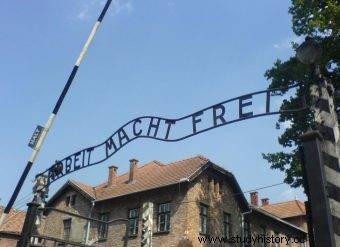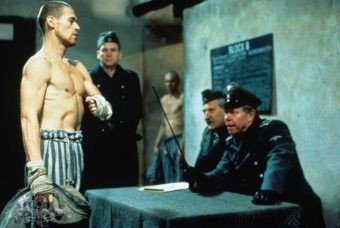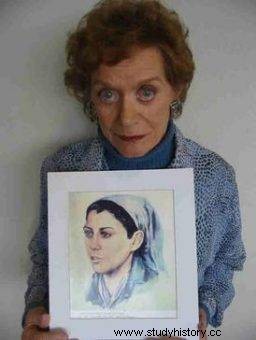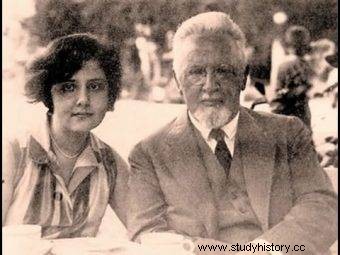A duel of will, an attempt at resourcefulness or an extraordinary smile of fate? These people kept their lives despite having been in death camps for many years. How did they manage to do this?
Those who worked harder in Auschwitz died faster - recalled years later Władysław Bartoszewski, one of the most famous prisoners of the Auschwitz camp. He knew what he was saying.
Some of the ways of surviving behind barbed wire may seem downright improbable and resemble literary fiction. In the novel "Chess with Death" John Donoghue describes the case of the brilliant French Jew Emil Clément, who became the undefeated chess champion.
His talent was noticed first by the kapos, and then by the Nazis. The watchmaker became an involuntary participant in perverse entertainment. He was forced to play for his life and that of other inmates. Although these adventures did not really take place, the concentration camps did not lack equally dramatic, authentic games.
A life fought on fists
Salamo Arouch was 20 years old when in 1943 he and his relatives were taken to the camp barrack in Auschwitz. Despite his young age, this Greek of Jewish origin has already had considerable sports successes.

The famous gate to KL Auschwitz with the inscription "Arbeit macht frei". One thing is certain, work did not make Auschwitz free. On the other hand, hard physical work was usually killing. Lucky were those who ended up in the camp orchestra or had some other special skill that the Germans found useful (author:Neil, license:CC BY-SA 3.0).
A year before the outbreak of World War II, Salamo won the Greek championship as a middleweight boxer. In turn, in 1939 he won the title of the champion of the Balkans. He has been involved in fistfighting since he was a child. His father, a port worker, infected him with his passion. When, at the age of 14, young Arouch played his first serious boxing match, could not expect the sport to save his life soon.
After crossing the gate with the inscription "Arbeit macht frei", he was given the number 136954. On the second day of his stay in the camp, he lost his entire family - his wife and children went straight to the gas chambers.
Salamo was saved by her physical prowess. Seeing a young, athletic man, the Germans recognized him as fit for work and did not select him for immediate death. A few days later it caught the eye of the Nazis who traveled the camp in search of prisoners who could fight unequal boxing duels for their amusement.
I was terrified. I haven't eaten anything for several days. But still, I decided to give it a try - years later, he revealed Salamo to journalists of the Israeli daily Haaretz.

Seeing a young, athletic man, the Germans recognized him as fit for work and did not select him for immediate death. Salamo Arouch survived the concentration camps thanks to boxing (frame from the film about his fate, entitled "The Triumph of the Spirit" from 1989).
At stake in the fight was the life of the "competitor" or an extra portion of food. The loser immediately went to the gas chamber. The Greek has fought in over 200 life and death duels. More than once he had to fight with players much larger than himself. In 1989, the movie "Strength of the Spirit" was made.
Polish boxer Tadeusz "Teddy" Pietrzykowski fought similar battles for survival in Auschwitz-Birkenau. He, too, had considerable boxing success before the war. He even won the title of vice-champion of Poland in the bantamweight scale.
Although he was one of the first prisoners (number 77) in 1940, he was imprisoned in a striped uniform in the ring only in 1941. His opponent was the grown-up capo Walter Dunning, pre-war German middleweight champion.
The fight was not resolved because, to the German's surprise, the prisoner, exhausted by work and hunger, bravely kept pace with his torturer. Not wanting to embarrass himself in the eyes of the other overseers and prisoners, Walter ended the fistfight. From then on, he organized fights in which ... he was betting on Pietrzykowski's victory!

Tadeusz "Teddy" Pietrzykowski / photo:YouTube.com
In total, "Teddy" fought several dozen fist fights, for which he usually received an extra portion of food. More than once he has faced much larger and less emaciated opponents. He dueled not only with his fellow prisoners, but also with the Nazis. "He beat the Germans as he wanted" - Tadeusz Borowski will say about him years later.
The good streak of the Polish "chucherka" quite quickly ceased to appeal to representatives of the Master Race. His life was saved by boxing again, specifically the pre-war boxing judge Hans Lütkemayer.
Pietrzykowski met him during the competition before the start of World War II. Lütkemayer learned that the camp Gestapo had targeted the Polish athlete. He quickly offered him a transfer to the Neuengamme concentration camp, which he headed. Tadeusz also fought in the new place of sentencing.
He found himself in trouble again, but he managed to survive until the liberation of the camp. Based on his biography, Józef Hen wrote the book "Boxer and Death", later screened by Peter Solan.
Experience painted with paints
Some of the prisoners died in the camp by talent. As bizarre as it sounds, it was artistic sensitivity that could save people from the crematorium. The SS men valued painting quite highly. It was, however, an art of a special kind. Prisoners were forced to create portraits of other camp victims who were subjected to cruel medical experiments.
Thanks to such work in Auschwitz and Birkenau, a Jewess from Bohemia, Dina Gottliebova, managed to survive. Initially, a sculpture and graphic student was delegated to paint numbers on the barracks. With time, the camp guards ordered portraits of their wives and girlfriends from her.
She started working for Dr. Mengele after she painted a scene from the Disney fairy tale "Snow White and the Seven Dwarfs" in the children's barracks. The image caught the eye of a sadist who carried out shocking medical experiments (perhaps because it was impossible to watch American fairy tales in Nazi Germany, Hitler and those around him loved Disney's work).

Dina Gottliebova found work for Dr. Mengele after she painted a scene from the Disney fairy tale "Snow White and the Seven Dwarfs" on the children's barracks (photo:public domain).
In 1944, Dina is sent to work in a Gypsy camp. Her watercolors are meant to replace photos (Mengele is disappointed with the quality of the photography, he wants something more precise that will reflect every detail). Young Gottliebova is to paint portraits of Roma used in his pseudoscientific projects.
While he is creating for the "angel of death", the entire transport of Czech Jews from Terezin is dedicated to gassing. She is saved from death in the chamber by the intervention of Mengele, who wants the woman to finish her task. Apart from herself, Dina also managed to save her mother, Jana. Other prisoners survived the camp horror as well, and by painting pictures for SS men, they earned a little better treatment.
They played to survive
Being a member of the camp orchestra was also a chance to be saved. Only the Nazis could come up with the idea of a horror film to organize an orchestra in a place where hundreds of people died every day, which was to "make their work pleasant". A female, but also male, music group performed in hospital barracks, accompanied the marches of prisoners leaving for backbreaking work and performed "on request" of SS-men who were hungry for entertainment.
The music was also to accompany prisoners arriving in new transports. The members of the orchestra were forced to play lively, fashionable melodies as their neighbors, friends, family marched a few meters away to the gas chamber ...
Working in the orchestra brought noticeable profits. The musicians were given more food, more frequent baths and exercised in heated barracks. They were also not assigned to the hardest work and could count on better treatment in the hospital barrack.
One of the women who managed to survive thanks to music was the Polish violinist Helena Dunicz-Niwińska. She came for wires from Lviv together with her mother. At the time of recording, she admitted that she could play the violin. After a few days, she was called for questioning. Getting into the camp orchestra in Auschwitz was not an easy matter. As Niwińska recalls, it was necessary to pass an exam (literally for life) in front of an Austrian of Jewish origin, the outstanding violinist Alma Rosé.
 Mrs. Rose, although she was a prisoner herself, earned something like immunity due to her outstanding talent. She was the only prisoner who could wear elegant civilian clothes. In her book, Helena Dunicz-Niwińska mentioned years after the liberation that playing in the camp evoked mixed feelings among the musicians. They wanted to survive, but it seemed criminal to perform hits when crowds of innocent people were brutally murdered nearby.
Mrs. Rose, although she was a prisoner herself, earned something like immunity due to her outstanding talent. She was the only prisoner who could wear elegant civilian clothes. In her book, Helena Dunicz-Niwińska mentioned years after the liberation that playing in the camp evoked mixed feelings among the musicians. They wanted to survive, but it seemed criminal to perform hits when crowds of innocent people were brutally murdered nearby.
Alma Rosé, mentioned earlier, allegedly had one answer to these dilemmas - the orchestra is life.
Inspiration:
The inspiration for this article was John Donoghue's book "Chess with Death". You can buy this book with a 30% discount.
Literature:
- Marak Roy, Survived Auschwitz by boxing, Haaretz Roy, Haaretz.com April 30, 2009.
- Bogacka Marta, A boxer from Auschwitz. The fate of Tadeusz Pietrzykowski, Demart 2012.
- Dunicz-Niwińska Helena, Dear my life. Memoirs of a violinist from Birkenau , Auschwitz-Birkenau State Museum 2013.
- Newman Richard, Kirtley Karen, Alma Rosé:Vienna to Auschwitz . Amadeus Press 2003.
- Ostałowska Lidia, Water paints , Black 2011.
